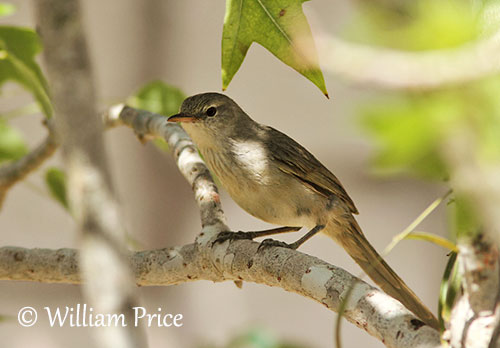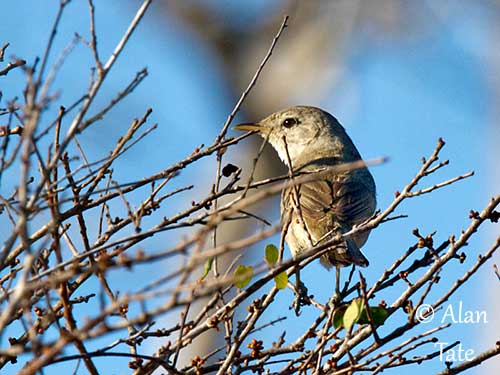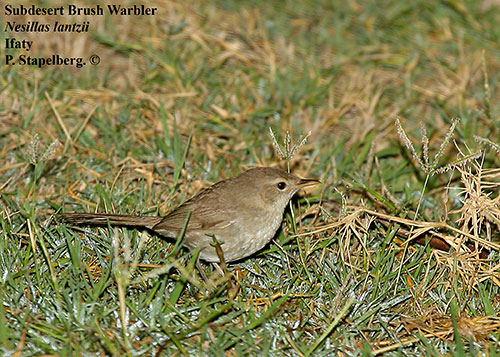
REPRODUCTION OF THIS SPECIES:
The breeding season takes place between August and February, with peak in October/December.
The Subdesert Brush-Warbler builds a nest close to the ground, a cup-shaped structure placed low in bush or in clump of grass.
The female lays two eggs.
Usually in Old World Warblers, the incubation varies from 9 to 17 days, but this period seems to be longer for tropical species, with 14-15 days in average.
At hatching, the chicks are altricial, naked and blind. They are brooded during several days. Both parents feed them, but the female does most of the work.
In case of co-operative breeding, the helpers take part in incubation and chick-feeding.
The chicks leave the nest often before they are able to fly properly. They remain in the area for some weeks after fledging.
But this information is for Old World warblers in general, and more knowledge is needed for the present species.
PROTECTION / THREATS / STATUS:
The Subdesert Brush-Warbler has restricted range in which it is common to locally very common in SW Madagascar.
The population is not expected to be declining as the species has adapted to degraded habitats.
The Subdesert Brush-Warbler is not globally threatened and currently evaluated as Least Concern.
Fr: Nésille de Lantz - Nésille du pré-désert
Ang: Subdesert Brush-Warbler
All: Lantzbuschsänger
Esp: Zarzalero de Lantz
Ita: Nesilla del deserto
Nd: Lantz' Zanger
Sd: halvökensångare
Photographer:
William Price
PBase-tereksandpiper & Flickr William Price
Philip Stapelberg
GALLERY
Alan & Ann Tate
AA Bird Photography
Text by Nicole Bouglouan
Sources :
HANDBOOK OF THE BIRDS OF THE WORLD Vol 11 by Josep del Hoyo, Andrew Elliott and David Christie - Lynx Edicions - ISBN: 849655306X
Birds of Madagascar and the Indian Ocean Islands Par Roger Safford, Adrian Skerrett, Frank Hawkins – ISBN: 1472924118, 9781472924117- Editeur: Bloomsbury Publishing, 2015
The Birds of Africa: Volume VIII: The Malagasy Region: Madagascar, Seychelles, Comoros, Mascarenes - Par Roger Safford, Frank Hawkins – ISBN: 1408190494, 9781408190494- Editeur: A&C Black, 2013
Birds of Madagascar: A Photographic Guide Par Pete Morris, Frank Hawkins – ISBN: 0300077556, 9780300077551- Editeur: Yale University Press, 1998
Wildlife of Madagascar par Ken Behrens,Keith Barnes - ISBN: 140088067X, 9781400880676 – Editeur: Princeton University Press, 2016
Birds of the Indian Ocean Islands Par Ian Sinclair, Olivier Langrand - ISBN: 1868729567, 9781868729562- Editeur: Struik, 2003
Reed and Bush Warblers Par Peter Kennerley, David Pearson – Helm Identification Guides - Editeur: A&C Black, 2010 – ISBN: 1408134012, 9781408134016
Subdesert Brush-Warbler
Nesillas lantzii
Passeriformes Order – Acrocephalidae Family
INTRODUCTION:
The Subdesert Brush-Warbler is endemic to Madagascar and occurs in the sub-arid region of S and W of the island. It was formerly a subspecies of Nesillas typica, but it is now a full species in the Old World Warblers.
This species is adapted to life in semi-arid habitats and spiny forest. It is reported to be not uncommon throughout its restricted range.
DESCRIPTION OF THE BIRD:
Biometrics:
Length: 17 cm
The Subdesert Brush-Warbler has pale greyish-brown upperparts and upperwing coverts, whereas rump and uppertail-coverts are more ochreous. Both flight and tail feathers are dark grey-brown with greyish-buff edges. The tail is fairly long.
The underparts are buffy-white with greyish flanks. The breast shows indistinct darker streaks.
On the head, crown and sides are pale greyish-brown. We can see a well-defined buffy-white supercilium and a dark eyeline.
The bill is brownish on upper mandible and mostly flesh-coloured with darker tip on lower mandible. The eyes are brown, surrounded by narrow, white eyering. Legs and feet are blue-grey.
Male and female are similar.
The juvenile is usually duller, with more uniform grey-brown plumage.

RANGE:
The Subdesert Brush-Warbler occurs in SW and S Madagascar where it is common in S coastal scrub from Mangoky to just E of Taolagnaro. It is less common further N along the W coast, and may extend inland to the limit of S subdesert forest.
HABITAT:
The Subdesert Brush-Warbler frequents subarid thorn scrub, subdesert forest, Euphorbia forest and low coastal scrub. It can be seen at the edge of the lowland evergreen forest, in secondary growth, degraded Didierea forest and gardens. The species is visible from sea-level up to 500 metres of elevation.
CALLS AND SONGS: SOUNDS BY XENO-CANTO
The Subdesert Brush-Warbler gives series of rapid, high-pitched “trreeeek trreeeek trreeeek” or “tik… triiik… tikikikikik” used as contact call. This species appears to lack structured song.
BEHAVIOUR IN THE WILD:
The Subdesert Brush-Warbler feeds on small invertebrates such as insects and spiders. It forages low in the thick undergrowth. It is usually seen alone or in pairs, and they are often detected by their calls.

The breeding behaviour of this species is poorly known.
Generally, most warblers appear to be monogamous. However, the Malagasy genus Nesillas has been considered allied to Seychelles Warbler of genus Acrocephalus that demonstrates co-operative breeding habits. But more information is required.
The Subdesert Brush-Warbler is resident and sedentary within its restricted range.
The short, rounded wings probably allow only short-distance flights.
